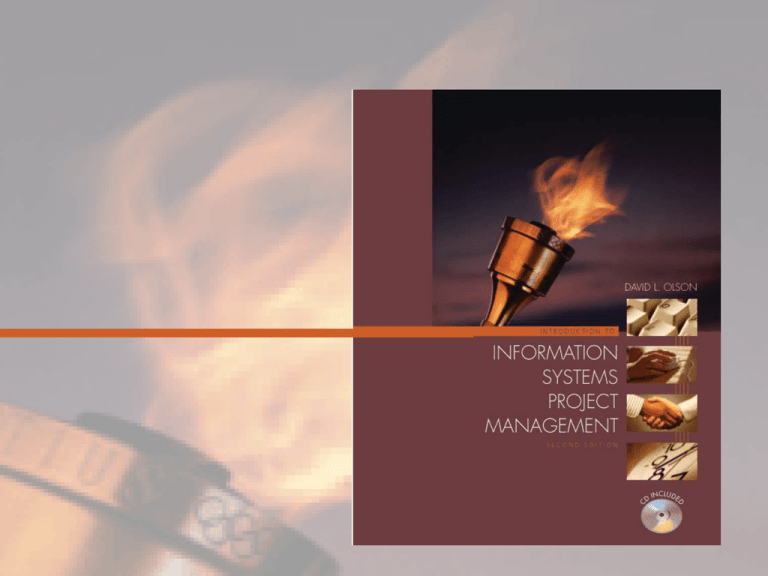Information Systems Project Management—David Olson 2-1 © McGraw-Hill/Irwin 2004
advertisement

Information Systems Project Management—David Olson 2-1 © McGraw-Hill/Irwin 2004 Information Systems Project Management—David Olson 2-2 Chapter 2: Human Aspects IS project work environments Common project team problems Communication Differences: Functional & Project © McGraw-Hill/Irwin 2004 Information Systems Project Management—David Olson 2-3 Cooperation • IS projects bring diverse people together – Working with computers creates a machine focus in some – Working with people creates a different mindset – IS project managers need to make both work together © McGraw-Hill/Irwin 2004 Information Systems Project Management—David Olson 2-4 IS Project Features • Very valuable • Highly diverse – – – – Web sites Transactional processing Decision support systems Enterprise resource planning systems © McGraw-Hill/Irwin 2004 Information Systems Project Management—David Olson 2-5 Waterfall Development Model Stage Personnel Feasibility analysis Systems analysts, users, finance Software requirements Systems analysts, users Product design Systems analysts Detailed design Systems analysts Coding Programmers, Testers Integration Systems analysts, Programmers, Testers, System administrators Implementation System administrators, Testers, users Operation & Maintenance Maintenance © McGraw-Hill/Irwin 2004 Information Systems Project Management—David Olson 2-6 IS Group Conflict • Conflict inherent in – Human organizations – information systems • Lack of trust & understanding • Hostility • Frustration • Barki & Hartwick [2001] • Disagreement • Interference • Negative emotion © McGraw-Hill/Irwin 2004 Information Systems Project Management—David Olson 2-7 IS Project Characteristics & Conflict Barki & Hartwick [2001] Individual Team Personality Size Background Project Time pressure Heterogeneity Resources Role & status Leadership Success Individual goals Top support Participation History © McGraw-Hill/Irwin 2004 Organization Culture Form Information Systems Project Management—David Olson 2-8 Individual Characteristics • Personality – Technical people tend to dominate IS projects – Users need to participate as well • Background – Different education, experience • Organizational Role & Status – Hierarchical power won’t match expertise • Individual Needs & Goals © McGraw-Hill/Irwin 2004 Information Systems Project Management—David Olson 2-9 Team Characteristics • Team size – Larger tends to have more conflict • Team heterogeneity – More diverse tends to have more conflict • Team Leadership • Participation • History © McGraw-Hill/Irwin 2004 Information Systems Project Management—David Olson 2-10 Project Characteristics • Time pressure inherent in most IS projects – People react differently • Resource constraints – Often have to work with what’s available • Success criteria – Expectations • Top management support © McGraw-Hill/Irwin 2004 Information Systems Project Management—David Olson 2-11 Organizational Characteristics • Organizational culture • Form of organization – Many project organizations use Matrix • Creates high pressure, highly dynamic environment © McGraw-Hill/Irwin 2004 Information Systems Project Management—David Olson 2-12 Conflict & Performance • Better to avoid interpersonal conflict – High conflict in some high performing groups • Need to be able to reach closure – Low performing groups often had less conflict until the end • Encourage – Open discussion – High levels of personal respect – Cohesive & supportive team leadership © McGraw-Hill/Irwin 2004 Information Systems Project Management—David Olson 2-13 Organizational Forces Impeding IS Success Ward [1995] 1. Project scope & objectives rarely communicated to project team 2. Business rationale for project rarely disseminated 3. Project budgets inaccurate (or skipped) 4. Lack of project support 5. Project control contested or not firmly established 6. Rules changed during project execution © McGraw-Hill/Irwin 2004 Information Systems Project Management—David Olson 2-14 Project Communication • Communications barriers natural – Within or across organizations • In traditional organizations, people cope – In Projects, don’t know ropes • (projects are new) © McGraw-Hill/Irwin 2004 Information Systems Project Management—David Olson 2-15 Customer Relationship Management Marks & Frolick [2001] • Popular advanced information technology • Data mine large sets of data – Find details of what each customer wants – Customer segmentation – Cross-selling • Very expensive – Return can be very high © McGraw-Hill/Irwin 2004 Information Systems Project Management—David Olson 2-16 CRM Project • Implementation of data warehouse – Needed to store large amount of data – Monitor value of each customer – Cross-selling opportunities • Hired consultant to help implement – Needed to merge many brand files • Problems – – – – Defining database fields Lack of cooperation across brands No influential project champion Consultant didn’t understand organization © McGraw-Hill/Irwin 2004 Information Systems Project Management—David Olson 2-17 CRM Project cont. • Initial project failed • Second attempt – – – – More focused goals established New project leadership Consultants let go Less functionality, more controllable • 2nd effort successful, project profitable © McGraw-Hill/Irwin 2004 Information Systems Project Management—David Olson 2-18 Project Managers • Get work done through outsiders – Diverse people on project team • Different skill sets • From different organizations • Projects are temporary – Matrix common • Dual lines of authority • Requires ability to convince • Generalist rather than specialist © McGraw-Hill/Irwin 2004 Information Systems Project Management—David Olson 2-19 Comparison Functional manager Project manager Clear authority; quasipermanent; can direct Low authority; temporary; must convince Established organization Developing organization Long-term relationships Short-term relationships Small set of skills managed Diverse set of skills managed © McGraw-Hill/Irwin 2004 Information Systems Project Management—David Olson 2-20 Summary • Information systems projects very valuable • Many difficulties in managing personnel – – – – New activities Diverse people Dynamic environment Pressure (time, budget) • IS Project Managers need special abilities – Get things done without authority © McGraw-Hill/Irwin 2004




